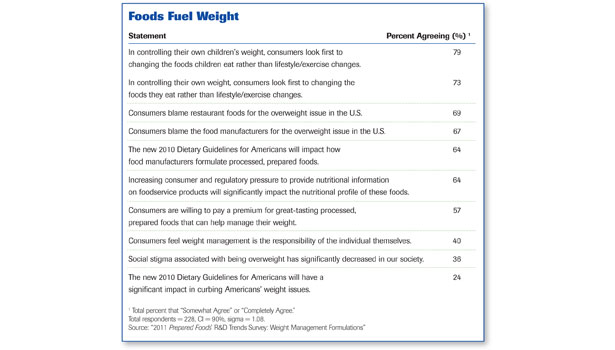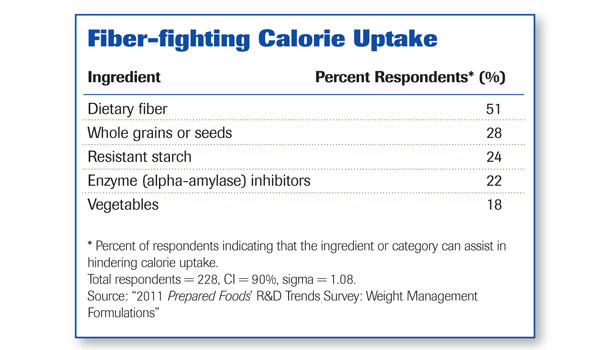Obesity: America’s Number One Food Issue








“It is about the quantity of food. We have trained ourselves in the U.S. to think a serving of meat is equal to two to three decks of cards [in volume] vs. one deck of cards. Or, a serving of cereal is one bowl, which in most cases is 2-3 servings’ worth.”
“Often, people want to place the whole of the blame on the food industry. However, if demand for (unhealthy) products didn’t exist, the industry would not create them.”
-- Respondents to the “2011 Prepared Foods’ R&D Trends Survey: Weight Management Formulations”
During a period of time between July 27-August 15, 2011, Prepared Foods magazine, in conjunction with BNP Media’s Market Research Division, conducted its annual “2011 Prepared Foods’ R&D Trends Survey: Weight Management Formulations.” The focus was to provide information on current trends and growth opportunities for manufacturers and marketers of weight-control products.
Beyond ingredient- and formulation-oriented data presented in this piece, the passion of the subjects shows through. The survey’s 228 respondents volunteered 156 comments on the issue, some of which are scattered throughout this article. Indeed, the crisis of overweight populations is a global one that impacts virtually every country, and the food industry is responding.
The Cost of Obesity
“Consumers will look to foods and diet first, before exercise and other lifestyle changes, when it comes to weight control and management.”
“Cost and convenience will continue to be drivers of obesity in North America; moderation may be the most effective approach.”
-- Respondents to the “2011 Prepared Foods’ R&D Trends Survey: Weight Management Formulations”
The issue of being overweight goes beyond personal well-being. Obesity extracts a huge economic burden on society. The January 2011 issue of the McKinsey Quarterly notes, “An obesity pandemic has put pressure on healthcare systems throughout the world.” It reports the UK spent over £4 billion on obesity-related medical costs in 2007, and the U.S. now spends some $160 billion a year; the amount could double by 2018. The newsletter relayed that indirect costs attributed to obesity are even greater and amount to at least $450 billion annually. Examples of indirect costs include $90 billion, due to incremental food expenses, and $30 billion for plus-size clothing paid by individuals. Costs footed by employers include $70 billion in decreased employee productivity and $30 billion in absenteeism.
In an economy where national debt (more than $14 trillion) plays a pivotal political and public policy role, one should ponder the nearly half a trillion dollars per year in costs due to overweight and obese citizens.
While the U.S. is said to lead the world in obesity, other nations are vying for the lead. A World Health Organization table (http://apps.who.int/bmi/index.jsp) lists, by country, the percent of adults that have BMIs equal or over 25 (i.e., that are overweight or obese). They caution the data is not directly comparable; however, it indicates the global nature of the challenge. The table reports 66.9% of the U.S. population was overweight or obese in 2005-2006. Populations in the South Pacific may be even heavier. Some 73.7% of French Polynesians were overweight/obese in 1995, and 93.5% of American Samoans in 2004. Other countries with rates similar to the U.S. include: Panama (67.4% overweight or obese from 1999 data), Saudi Arabia (72.5% in 1995-2000), UK/Northern Ireland (61% in 2002) and Germany (66.5% in 2002-2003).
Who were the leanest? According to the WHO chart, Vietnam checked in with 5.2% in 2002, and 1998 data puts India at 4.5% as overweight or obese. However, obesity levels are creeping up in developing economies, as well. More recent data projected India’s overweight/obesity rate at 18-20% for 2010. See http://tinyurl.com/yj8722d.
Who or What is to Blame for Globesity?
“I believe the problem is that people need to begin to be pro-active; there is more food available now that is healthy than ever before; at some point, the individual must be responsible.”
-- Respondent to the “2011 Prepared Foods’ R&D Trends Survey: Weight Management Formulations”
What is to blame for world weight gains? High-fructose corn syrup (HFCS), no doubt. [Editor’s note: Sorry, I’m joking; I couldn’t help myself.] However, both the cause and the solution to obesity have, indeed, resulted in much finger-pointing.
A series of papers published in the August 26, 2011, Lancet discusses many facets of obesity. The reviews are available with free registration at www.thelancet.com/series/obesity. One paper, “The global obesity pandemic: shaped by global drivers and local environments,” (Swinburn, BA, et al. 2011. Lancet. 378(9793):804-14), suggests increased obesity in almost all countries appears driven by changes in the global food system--a system that is producing more processed, affordable and effectively marketed food. The researchers write that, although there is still great variability within populations due to differences in environmental and individual factors, predictable patterns exist. “In low-income countries, obesity mostly affects middle-aged adults (especially women) from wealthy, urban environments; whereas, in high-income countries, it affects both sexes and all ages, but is disproportionately greater in disadvantaged groups.”
The researchers theorize that in high-income countries, an energy balance “flipping point” occurs in time, as the nation industrializes and people expend less energy, or calories. First, there is a “stay lean phase.” In the U.S., it occurred between 1910-1960. During this phase, physical activity decreased due to industrialization, but calorie intake also decreased. A second, “eat more, gain weight phase,” is then ushered in.
This phase is characterized by increased calorie intake and weight levels. The researchers point to “increasingly available, cheap, tasty, highly promoted ‘obesogenic’ foods” as a reason why higher food consumption occurs, when compared to the initial phase. Strategies to counter this take many forms.
“In order to curb this trend, several things need to happen,” says Loren Ward, Ph.D., director of R&D with a nutritional ingredient supplier. There should be improved national programs educating people on how to monitor energy intake and expenditure and to inform them of options available for help. Almost without exception, obese individuals desire to lose weight, but many either do not know what to do or do not have an appropriate support structure to help them through the process, Ward adds. “Most success stories are a result of individuals that have searched, studied and found a weight-loss path that works for them. It may have components of dieting, exercise, counselling, prepared meals, support groups and so on…but it works for them.” There needs to be a paradigm shift, rather than using a one-size-fits-all approach, Ward says.
In the 2011 Prepared Foods’ survey, when respondents were asked about consumer attitudes toward balancing energy intake vs. energy use, they clearly felt consumers look to food, rather than exercise, as the way to manage weight. Specifically, the survey asked: “Please indicate your level of agreement with the following statement” and listed 10 comments in regards to weight management. Some 79 and 73% feel the consumer looks to changing their children’s or their own diets, respectively, rather than making lifestyle/exercise changes. Some 69 and 67% feel consumers blame restaurant and food manufacturers, respectively. Only 24% feel the 2010 Dietary Guidelines for Americans “will have a significant impact in curbing Americans’ weight issues.” (See chart “Foods Fuel Weight.”)
Food availability, along with portion size, may well be a basic factor in obesity. A presentation titled, “Portion Distortion,” by the U.S. National Heart, Lung, and Blood Institute Obesity Education Initiative, asks, “Do You Know How Food Portions Have Changed in 20 Years?” (See http://tinyurl.com/ybrfp7b.) The presentation points out that some 20 years ago, a bottle of soda was 8.5oz and contained 85 calories. Now, a bottle is 20oz and 250 calories. A 160lb person would have to work 35 minutes in a garden to burn off the extra calories. A turkey sandwich was typically 320 calories some 20 years ago, while today it is some 820 calories. Burning off the 500-calorie difference would require 1 hour, 25 minutes of bike riding. Servings of bagels to burgers, French fries to spaghetti and meatballs have all been “supersized.” Expecting consumers with often time-starved lives to “exercise it off” can be only part of the solution. Controlled food consumption is a key factor.
The Industry Responds
“It starts and finishes with great taste. If you don’t have it, don’t bother. The rest is a moot point.”
“Most weight management foods currently at retail are quite good these days, and portion control is very helpful to someone on a weight-loss plan.”
-- Respondents to the “2011 Prepared Foods’ R&D Trends Survey: Weight Management Formulations”
Through the decades, the food industry has offered consumers products addressing weight management in many formats, from diet and low-fat foods to, more recently, satiety products. Speakers at an October 5, 2011, virtual trade show on weight management, held by Prepared Foods, provided a recent industry overview. (The show, including presentations, is available on-demand at http://tinyurl.com/3gjd4ez, until April 2012.)
In a presentation titled, “What’s New in Weight Management,” Lu Ann Williams, head of research, Innova Market Insights, reviewed new product offerings by manufacturers. Innova data shows 20.0% of products launched globally from January 2008-October 2010 that made a weight management claim were under the Weight Watchers label. The Special K brand fell into second place, with 8.9% of the new product launches making a claim; Healthy Choice came in third at 6.4%; Lean Cuisine at 5.0%; and Nestle’s Fitness/Sveltesse at 4.6%.
Looking in more detail at the types of claims made, Williams noted products claiming “satiety” have never really taken off. However, references about a product being “filling” have increased in use. An example is Weight Watchers using the verbiage “Rely on Weight Watchers Power Foods--filling, healthy choices” to explain how its products work. Weight Watchers’ promotional material also notes it is a plan “based on the latest nutritional research.”
Science-based support for claims may well be increasing in importance. “Much research is still needed to understand satiety signalling and what impacts satiety signalling,” says Ward. Satiety signalling is impacted by more than just food. For example, exercise, stress, genetics and environment may all influence eating patterns and satiety signalling. “I don’t think that satiety signalling will be as simple as consuming one ingredient,” Ward adds. “It may take multiple adjustments along the lines of variables that impact hunger, satiety and eating patterns. Being able to see this larger picture is important, because I don’t think consumers should think one small change will provide all of the answers.”
Although messages on metabolism have never really transferred well to packaged foods, there is a growing trend in this area, also, says Williams. Global claims related to “increasing metabolism” have increased 147% from 2008-2010, although the initial number was very small, Williams admits. Jenny Craig’s Metabolic Max program is one example. Williams suggested metabolism references are more technical and, thus, a more difficult concept for consumers to grasp. However, they can now be supported by background educational information provided through social media, websites and so on.
Innova data also showed a 55% increase since 2008 in global products making some type of fat-burning/-distribution claim, and an increase of 5.3% during the same 2008-2010 period with products using a portion control platform. “We’ve heard about the demise of portion control, but we haven’t found that at all,” says Williams. In the U.S., “portion control” is likely one aspect of the trend towards “structurally thin” foods, a trend seen in both retail and foodservice products. One example is the newly introduced line of Bagel Thin Bundles from Einstein Bros, where the bagels used for the bread portion of sandwiches is thinner than a traditional bagel.
Ingredient Formulations
Certain ingredients have a reputation for specific benefits or properties. Williams noted fiber and protein are often connected with products with fullness claims; that green tea and its EGCG component, L-carnitine; Hoodia gordonii; oligofructose; and B vitamins, among others, are associated with increased metabolism; and CLA (conjugated linoleic acid) and chitosan are often aligned with products positioned for their ability to support body shaping or optimal fat distribution.
Investigating the reputation of various ingredients among food processor staff involved in product development was another task of the 2011 Prepared Foods’ survey. For example, one question asked, “Which of the following ingredients assist in enhancing satiety?”--a list of 30 ingredients was then provided. When the responses were tallied, protein and “fiber-type” ingredients did indeed come out on top. However, respondents with sales and marketing functions tended to be more disbelieving than people with technical (R&D and QC) functions.
Overall, 70% of those that responded agreed dietary fiber could enhance satiety, with 78% of people in R&D saying so. But, only 52% of sales and marketing folks agreed. The two groups were in more harmony on “whole grains and seeds,” with 58% of R&D and 45% of sales/marketing agreeing the ingredient category increased satiety. The widest gap between sales/marketing and technical functions was in regards to opinions on hydrocolloid gums and satiety, where 39% of R&D/QC felt they could assist in satiety, but only 13% of sales and marketing recognized their ability to do so (and very possibly did not know what such ingredients were). Resistant starch, with fiber-like properties, was similarly recognized by 35 and 19% of R&D/QC and sales/marketing folks, respectively, as being able to enhance satiety. Hoodia gordonii is a popular supplement traditionally taken by South African Bushmen to suppress appetite during long hunting trips. It was only recognized by 7% of respondents in the Prepared Foods’ survey…all of them with technical titles.
Responses to the survey question, “Which of the following ingredients assist in altering metabolism?” were in harmony with Innova data. Of the items listed, green tea, followed by “stimulants such as caffeine, theobromine,” was identified by almost half of those surveyed. Dietary fiber and whole grains or seeds also ranked high, perhaps basking in the light of being “good for you, in general.” (See chart “Top Metabolism Enhancers.”)
When asked, “Which of the following ingredients assist in hindering calorie uptake?” survey respondents again leaned heavily toward fiber-type ingredients, with 51% of the respondents clicking off dietary. This included hydrocolloid gums and sugar polyols, with 16 and 14% of respondents, respectively, indicating those ingredients could hinder calorie uptake. Enyzmes that inhibit starch breakdown and, thus, calorie digestion, were identified by 22%. However, chitosan, the “animal fiber” well-studied for its ability to hinder fat uptake, was only recognized by 11% of those surveyed. (See chart “Fiber-fighting Calorie Uptake.”)
Respondents were generally knowledgeable about the ability of various ingredients to improve the taste and texture quality of products. When asked, “Which of the following ingredients can assist in improving sensory properties of weight management products?”--flavorings, high-intensity sweeteners, sugar polyols and hydrocolloid gums were checked off by 62, 53, 42 and 34%, respectively, of the respondents. Whole ingredients fared a little worse, with 41, 21 and 20% of respondents agreeing that fruits, vegetables and “whole grains or seeds” could improve the sensory properties of such foods and beverages.
While many point to the easy availability of great-tasting, but calorie-laden foods as the root of obesity, food manufacturers are striving to make great-tasting, but better-for-you products. pf
Looking for a reprint of this article?
From high-res PDFs to custom plaques, order your copy today!
 Claudia Dziuk O'Donnell is Chief Editor and Associate Publisher of Prepared Foods magazine including its NutraSolutions and Culinary sections. Her responsibilities include determining the editorial content of the print publication and the New Products Conference.
Claudia Dziuk O'Donnell is Chief Editor and Associate Publisher of Prepared Foods magazine including its NutraSolutions and Culinary sections. Her responsibilities include determining the editorial content of the print publication and the New Products Conference.






